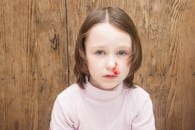Nosebleeds: Causes and Treatment
It can be very scary the first time this happens. You look at your child and notice that seemingly out of nowhere, for no apparent reason, he has a nosebleed. You don’t remember him injuring himself or scratching his nose. It seems like there is blood everywhere. You are naturally worried and may think of urgently calling your doctor or going to the emergency room. Relax, take a deep breath. Nosebleeds are virtually never dangerous and the blood loss is almost always minimal. Here are some tips to help you get through this nosebleeds in children.
CAUSES OF NOSEBLEEDS
Dr. Sears Tip: To uncover the cause, instead of asking your child, “Do you pick your nose,” ask: “Which finger do you use to pick your nose?”
- Nose picking – this irritates the nose and exposes blood vessels that can easily be scratched open.
- Trauma – getting hit in the nose often causes bleeding. This doesn’t mean the nose is broken or anything serious has happened.
- Sinus infection, nasal allergies, or a bad cold – severe nasal congestion and irritation can cause bleeding.
- Dry air – this dries out the nasal lining and can be irritating, especially in a heated room.
- Bacterial infection or impetigo – the nasal lining just inside the nose past where the skin ends is susceptible to infection from bacteria. It causes a red, sore, crusty area just inside the nose and on the skin in the front of the nostrils. Bacteria can irritate this area even without an obvious sore, crusty patch.
- Blood clotting problems – this is rare and seldom worth checking for unless your doctor has a concern about this possibility.
RECURRENT NOSEBLEEDS
Some children will experience frequent nosebleeds from time to time. A few nosebleeds each year is no big deal, but when it happens a few times each weeks, this is more worrisome to parents.
Recurrent nosebleeds happen because part of the lining of the nose has become chronically irritated and the blood vessels exposed. These will bleed at the slightest provocation. The most common site of these vessels is on the nasal septum (the cartilage that divide the nose in half) just inside the nose past where the skin ends.
TREATING NOSEBLEEDS IN CHILDREN
To slow down and stop a nosebleed:
- Direct pressure – gently squeeze the nose shut with a cloth. Apply a wad of moist cotton into the side that is bleeding and squeeze nostrils together. Dr. Sears suggestions: 1) To effectively stop a severe nosebleed apply ice and/or pressure for a full 10 minutes.2) To avoid sneezing and loosening the clot have your child open and breathe through her mouth
- Pressure to the bridge of the nose – this squeezes the blood vessels flowing into the nose.
The two steps above generally stop most nosebleeds. For stubborn bleeds you can also try:
- Apply ice to the bridge of the nose – may also decrease blood flow.
- Lay down with your head tilted back.
- Remember to continue direct pressure to the nose. This is most important.
- Afrin nasal spray (neo-synephrine) – this is an over-the-counter decongestant spray that shrinks the blood vessels in the nose for ten minutes. It can help slow down or stop a stubborn nosebleed.
TREATING RECURRENT NOSEBLEEDS IN CHILDREN
- Moisturize – the key is to lubricate and moisturize the lining of the nose. Here are some ways:
- Nasal saline mist – spray this into the nostrils two or three times daily.
- Vaseline – gently rub this around just inside the nose with a Q-tip or your finger twice a day.
- Lanolin ointment – may work even better than vaseline.
- Vaporizer – in the bedroom can keep the air moist, and provide a more humid source of heat.
- Antibiotic ointment – apply an over-the-counter ointment to the red, sore areas just inside the nose twice day. This can also help heal any sore, exposed blood vessels on the nasal septum. If this doesn’t help, use a prescription ointment.
- Cauterize – An ENT specialist can cauterize the exposed blood vessels to stop stubborn cases.
WHEN TO WORRY ABOUT NOSEBLEEDS
Nosebleeds are virtually never a reason to call your doctor or go to the ER after hours. It may seem like your child has lost a lot of blood, but this is rarely a concern. Some children will waken in the night with a large spot of blood on the pillow. Don’t worry, it looks like more blood than it really is. Unless your child is acting extremely ill, this can wait until morning to seek medical attention.
It is also normal for children to swallow blood during a nosebleed. Blood in the stomach can be very irritating and will often cause the child to throw up or cough up the blood. This is to be expected.
There are two situations that warrant a trip to the ER or to call your doctor:
- Nosebleed with a severe headache – this can be a sign of high blood pressure. This should be checked right away.
- Nosebleed with other unusual areas of bleeding or bruising such as bleeding gums, blood in the urine or stool, or severe bruising all over the body.

